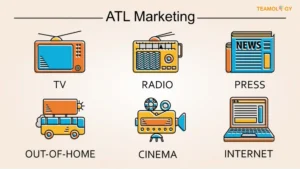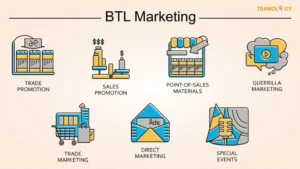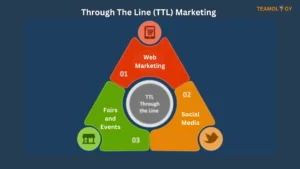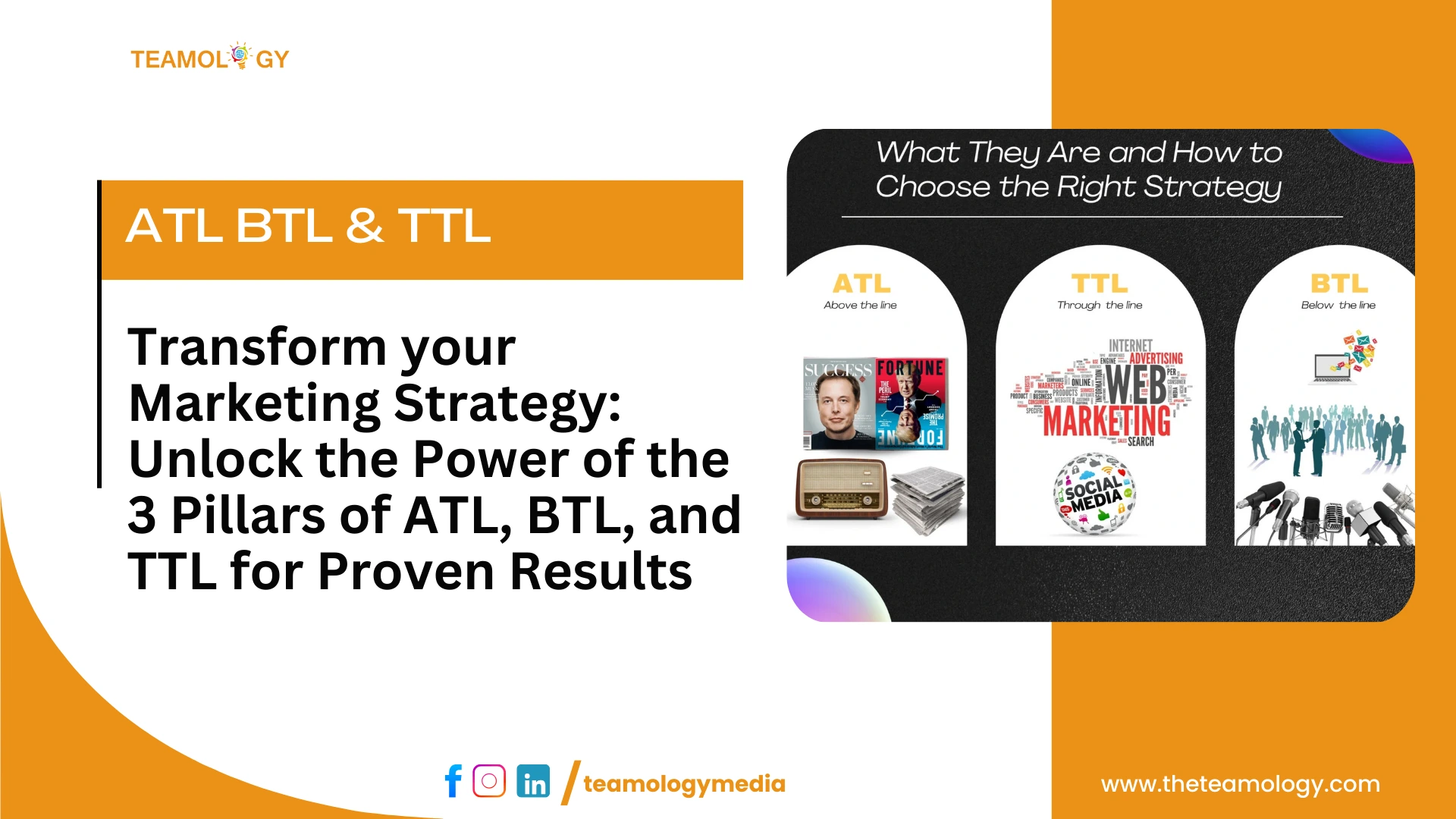A choice of strategy plays a critical role in determining the success of your campaigns in a fast-evolving marketing world. Indeed, businesses often get perplexed between ATL (Above-the-Line), BTL (Below-the-Line), and TTL (Through-the-Line) marketing. Every three frames has its unique method, approach, targeting, and impact. Decoding these marketing strategies to realign with the goals of your business is what unlocks your brand’s potential.
Understanding ATL (Above-the-Line) Marketing

ATL Marketing
Above-the-line marketing is a form of mass media advertisement targeting many people. Above all, it includes television, radio, print advertisements, and outdoor commercials. This medium not only provides significant exposure but also reaches a diverse range of target audiences without discrimination. As such, the above-the-line marketing strategy is applicable for companies in positioning a brand on the mass market. Here, the focus is on visibility and recall. Multinational soft drinks can be advertised in prime time on television, on high-traffic billboards, and in magazine placements, all aimed at achieving top-level exposure. The bottom line here is not to sell the product but to be able to attain a durable brand identity that clicks over time.
ATL campaigns are usually expensive and are used by organizations that have big marketing budgets and are open to expansion. At the same time, it may not be easy to measure return on investment because of the broad and generic nature of mass targeting. Consider ATL as a brand investment wherein the objective is longer-term memory and name recognition rather than quick-term tangible returns.
BTL (Below-the-Line) Marketing: Targeted and Tactical

BTL Marketing
In contrast, BTL marketing is focused and specific as it targets direct efforts of marketing communications with specific groups of people through personal selling, direct mail, sponsorships, and other experiential marketing efforts. BTL efforts are often used when seeking conversion and immediate customer engagement. The efforts are highly data-driven and meant to target a defined audience segment.
A classic example of BTL marketing would be when a skincare brand opens up a pop-up store within a busy mall, where free samples are given to passersby. Such marketing activities are highly interactive, communicating directly with prospects, and thus aim for trial and conversion. Other examples of BTL would include personalized email campaigns, influencer marketing, and event sponsorships, wherein brands can relay communication on an intimate, personal level.
The most important advantage of BTL marketing, or perhaps the highest challenge associated with it, is that it tends to be measurable. The very reason these campaigns are tailored to a specific audience will allow for easy monitoring of engagement levels, conversion rates, and ROI. Whereas BTL campaigns are generally not comparable in reach, their targeting can guarantee far more effective and sometimes faster responses from customers.
TTL Marketing: Connecting the Dots

TTL Marketing
TTL marketing is an approach that is a mix of ATL and BTL strategies, offering the mass reach of ATL and individual targeting of BTL in one marketing format. It is therefore an adjustable method combining both mass markets and market-specific consumer-directed markets, eventually transforming through brand awareness and measurable conversion. TTL marketing is very common in digital campaigns whereby social media, SEO, and content marketing are combined both in terms of mass outreach and individual targeting.
For instance, a retail brand such as Nike conducts a brand awareness campaign on TV. In addition to that, they use retargeting ads on social media for users who visited the site but didn’t buy from them. This method will help connect to wide audiences and personal follow-ups. Therefore, TTL marketing combines the earlier approaches while using multiple platforms for effective branding and customer engagement.
Selecting an Appropriate Marketing Strategy for Your Business
Based on the goals you set, the number of the target audience you expect to reach, the campaign budget, and the type of industry, you may consider ATL, BTL, or TTL for your marketing strategy.
1. Think About Your Brand Goals
If your objective is mass awareness and visibility, ATL can be the best course of action. Mass-based big brands look to use ATL strategies to hold their rank within the market. This can be achieved through advertising in various mass media infrastructures to ensure they remain constantly at the top of people’s minds.
Still, if you want to reach specific markets, get leads immediately, or establish a more personal contact, BTL is probably what you need. That is mainly because, for smaller businesses or startups with a small marketing budget, BTL marketing can be very targeted and measurable and operate within niche markets.
TTL may just be the remedy your brand needs when you want to pool together reach and precision targeting. For businesses operating in overcrowded markets, it is effective because it balances mass reach and direct engagement. After all, many digital-first brands use the integration of online and offline marketing through TTL strategies.
2. Know Your Audience
Knowing your target audience is the key to deciding what kind of marketing approach you will go for. ATL, of course, becomes perfect for mass-market products with vast and diverse demographics like FMCGs. BTL works better for niche markets if you deal with luxury items, special services, or high-end consumer electronics. TTLs come into play when your brand needs to appeal to both the masses and niche audiences. For example, a fashion house may use ATL routes such as tele commercials for awareness but use BTL tactics like influencer partnerships and social media ad-based targeting to reach customers who are interested in its products.
3. Budget and Resources
The most important factor in the choice of a strategy is the marketing budget. ATL campaigns require high investment through the cost of a large production process and a huge media placement. Usually, such big-sized companies prefer ATL so that on national or global platforms, awareness remains top-of-mind.
On the other hand, BTL campaigns are cheap and quite clear in terms of ROI through exact tracking methods. For small business enterprises, BTL marketing might be the only direct way and cost-effective option, because there is a higher chance of activation with less mass spending. TTL, as it merges ATL and BTL, can also be more adaptable compared to ATL in terms of budget management. As it has a mix of mass exposure and niche exposure with messaging, you can strike a better balance in terms of budget that allows you to get you more broader, niche exposures.
4. Industry Trend Analysis and Competitor Strategy
By studying your competition, you can make informed decisions on what strategy will be best for your business. Seeing these trends also helps you avoid future pitfalls. This also means that if your competition in the industry is driving mainly ATL campaigns and if you have enough budget to compete at this level, it’s worth checking out.
However, if most of the brands you are competing with are focusing on BTL or TTL approaches, then you will probably do way better by aligning with them or offering a balanced approach that no one has provided yet. Another market trend that offers a favorable dimension to TTL is the rising digital consumers. Therefore, with the incorporation of digital channels, you can introduce and upgrade your strategy as consumer habits change.
Conclusion
Right, ATL, BTL, and TTL marketing strategy is surely not a one-size-fits-all kind of choice. It requires a true inner understanding of one’s goals, customers, budget, and more about the industry dynamics that he or she must or wants to be involved in. ATL mass outreach helps create long-term brand awareness, BTL reaches the targeted set of audiences in the most immediate possible way, and TTL creates a comprehensive approach, combining both.
Ultimately, the biggest marketing success normally results from a combination of these approaches, supporting wide brand recognition and customer conversions at the desired levels. A careful survey of your business needs and objectives will help you craft a strategy to achieve maximum reach, engagement, and ROI to ensure survival in a fiercely competitive landscape.


